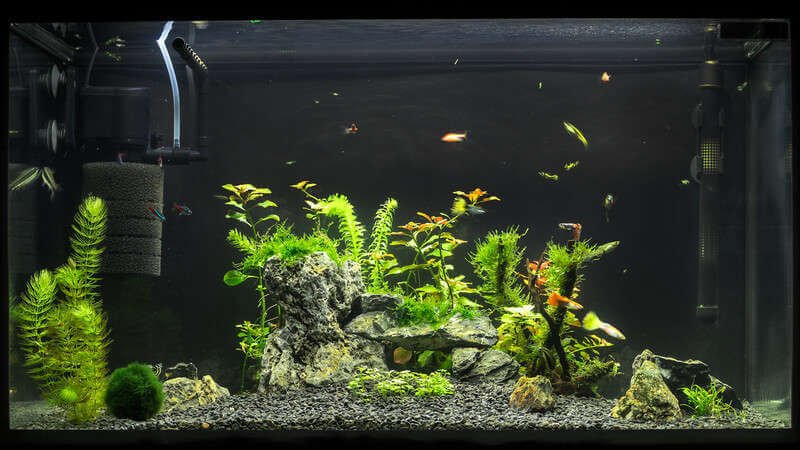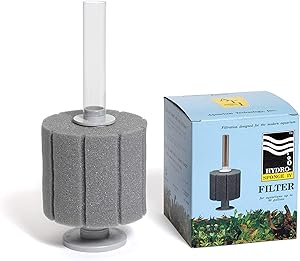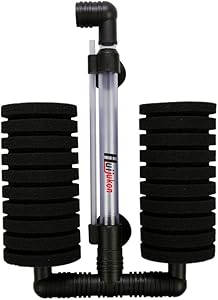One of the earliest, commercially available aquarium filters was the “sponge filter.” In today’s high-tech world of wireless aquarium lighting, smart-filters and specialty filter media the sponge filter seems old fashioned. Compared to a high-powered canister filter the sponge filter may appear useless at first glance.
But there is a reason why sponge filters are still used on thousands of aquariums today, even though there are many powerful aquarium filters to choose from. A low-tech sponge filter has many benefits and may be right for your aquarium. Here’s what you need to know about sponge filters!

In this article
- Best Rated Sponge Filters for Aquarium
- What does a sponge filter do?
- How a sponge filter works
- Sponge filters and mechanical filtration
- Sponge filters and biological filtration
- Sponge filters aerate the aquarium
- The simplicity of sponge filters
- Tip-Use a check valve!
- Sponge filters and bare aquariums
- Shrimp, seahorses and baby fish
- Using sponge filters with power filters
- Planted aquariums and sponge filters
- Myths about sponge filters
- How to clean a sponge filter
- What to look for when comparing sponge filters
- Final Recommendations
Best Rated Sponge Filters for Aquarium
The Hikari Bacto Surge sponge filter uses a weighted base design.
The filter is placed on the bottom of the aquarium and connected to your air pump. The highly porous sponge contains a high surface area with thousands of microscopic pores. Waste-degrading bacteria will colonize the sponge and break down ammonia and nitrite.
The sponge will also capture suspended debris floating in the water. The polyether foam stays soft, making it easy to clean and squeeze out debris.
Hikari Bacto Surge sponge filters are available in Large and Small versions. It is suitable for freshwater and marine aquariums.
Lustar has been making sponge filters for over 30 years. The HydroSponge line is used world-wide in freshwater and marine aquariums. The filter design uses a weighted pedestal base that keeps the sponge elevated and off the gravel bed.
Lustar HydroSponge filters use a large one-inch uplift tube for higher flow rates. The patented dense foam sponge traps dirt and is easy to clean.
There are five sizes to choose from:
- HydroSponge I: For aquariums up to 10 gallons
- HydroSponge II: For aquariums up to 20 gallons
- HydroSponge III: For aquariums up to 40 gallons
- HydroSponge VI: For aquariums up to 80 gallons
- HydroSponge V: For aquariums up to 125 gallons
The Huijukon sponge filter has a twin sponge design. The idea behind two sponges is greater surface area and less depth for the water to pass through. This allows for more flow through the thinner sponges.
You can also alternate cleanings between the each sponge. This will ensure one sponge is fully colonized with bacteria even if you have to replace the other. The Huijukon design attaches to the side of the aquarium glass with suction cups. This makes the filter less intrusive in the aquascape and reduces the “footprint” in your aquarium.
This sponge filter is easy to hide behind plants, rocks and driftwood. Huijukon sponge filters have an adjustable height uplift tube. This means you can position the filter lower in the aquarium and raise the uplift tube to the surface. The angled outlet, when placed at the water surface will create water movement and aeration at the tank’s surface.
This sponge filter is rated for up to 55-gallon aquariums. Replacement sponges are available as well as a filter kit complete with an air pump.
What does a sponge filter do?
You may remember there are three basic categories of aquarium filtration.
Mechanical filtration traps solid particles of debris like uneaten fish food, solid fish waste and dead algae cells.
Chemical filtration uses adsorbent media like activated carbon to remove dissolved organics that discolor the water and reduce water quality.
Biological filtration relies on nitrifying bacteria and other microbes to convert harmful byproducts, like nitrite and ammonia, to nitrate.
A sponge filter provides mechanical and biological filtration. It does not have chemical filtration properties.
How a sponge filter works
A sponge filter consists of a weighted base to keep the filter secure at the bottom of the aquarium.
Some designs don’t have a heavy base and use suction cups to attach the filter to the side of the aquarium.
No matter the brand, all sponge filters use an uplift tube to pull water through the sponge. The uplift tube is a vertical hollow pipe with perforations at the bottom. A porous sponge is wrapped around the perforated section of the uplift tube.
Here’s how an uplift tube moves water through the sponge:
- An aquarium air pump injects compressed air at the bottom of the uplift tube.
- The air bubbles rise and mix with the aquarium water inside the uplift tube.
- The air-water mixture in the tube becomes less dense. This causes the water to rise within the tube, causing a suction at the base of the uplift tube.
- The suction at the base of the filter pulls water through the sponge and out of the uplift tube.
Sponge filters and mechanical filtration
As water is pulled through the sponge it carries solid particles with it.
A sponge filter will trap uneaten food particles, dead plant leaves and solid fish waste. These organic particles collect inside the sponge’s pores.
Eventually the sponge will become clogged with decomposing organic matter if not cleaned on a regular basis. Water flow through the sponge will be reduced because many of the pores within the sponge will be packed with sludge and organic debris.
Sponge filters and biological filtration
Nitrifying bacteria use ammonia fish waste as an energy source, converting it to nitrite and then to relatively harmless nitrate. The bacteria can live in the water but tend to settle on solid surfaces and form colonies.
They’ll attach to the aquarium gravel, glass, ornaments, just about anywhere including the porous surface of a sponge filter. As water flows through the sponge, it brings ammonia to the nitrifying bacteria where it is consumed and detoxified.
Sponge filters aerate the aquarium
The rising bubbles disturb the surface of the water. This increases turbulence between the water surface and air above it. This water movement circulates water inside the tank and helps oxygen diffuse into the aquarium water.
The simplicity of sponge filters
Unlike power filters, sponge filters have no moving parts. All that is required is a small aquarium air pump to drive the filter. The filter is inexpensive and requires very little energy to run it.
A sponge filter will continue to aerate and filter even if the water level drops from evaporation. This make it a good filter to use while you’re away on a long trip and have no one to top off the aquarium.
Tip-Use a check valve!
Place a check valve in between the filter and the air pump. A check valve is a one-way valve that prevents water from back-siphoning and causing a flood.
If the air pump fails or there is a power outage, water can flow down the airline tubing and drain the tank.
A check valve is an inexpensive insurance policy!
Sponge filters and bare aquariums
Fish breeders, tropical fish wholesalers and fish shops use sponge filters for several reasons.
- Sponge filters provide an instant biological filter once it has “aged” for several weeks in another aquarium. You can move the sponge filter to any tank that needs biological filtration.
- It’s easy to remove the filter when catching fish or cleaning the aquarium.
- If fish need to be medicated, the sponge filter can be removed and placed in another tank until the treatment is complete.
Shrimp, seahorses and baby fish
Power filters move a lot of water. The suction at the filter intake can be quite strong. Freshwater shrimp, seahorses, fish fry and other weak swimmers can get sucked against the intake screen.
When you want a gentle flow, sponge filters offer an alternative to power filters.
Using sponge filters with power filters
Nothing beats the water flow from a hang-on-the-back power filter or a canister filter.
With a power filter you can use activated carbon to remove organics, discoloration and odors. Power filter cartridges even remove floating debris. But some aquarists like a sponge filter’s ability to capture very fine particles.
They’ll use a sponge filter, in addition to a power filter, to strain out tiny particles that pas through the power filter’s cartridge. Some aquarists use the sponge filter all the time. Others use one just when they want to clear up cloudy water or after a water change.
Planted aquariums and sponge filters
Aquarium plants need carbon dioxide as a nutrient. Aggressive surface agitation can drive off the CO2 gas, causing a shortage of carbon for the plants.
Sponge filters are an option in small to medium planted tanks because they don’t aggressively agitate the water surface (like power filters) and drive off carbon dioxide.
They’re also popular when keeping plants that like low water flow and freshwater shrimp like the delicate Red Crystal, Cherry and Sakura varieties.
Myths about sponge filters
Below are a few of the most common myths about sponge filters. You’ve probably heard a few of them.
Sponge filters release lead
False. Some sponge filters have a lead weight in the base to keep the filter submerged. Fears that lead will be released are unfounded. Sponge filters have been used in acidic water breeding aquariums and also commercial holding tanks that handle millions of fish every year. If you are still concerned, use a non-weighted sponge filter that uses suction cups.
Sponge filters spread disease
It depends. If you had a tank of sick fish and moved the sponge filter into another aquarium, it is possible to introduce the disease into the other aquarium. But odds are, if the fish are healthy, their immune system will quickly fight off the disease. Moving a sponge filter around in healthy aquariums is not a problem. It’s similar to using the same fish net in several tanks. If the tanks are healthy, nothing bad will happen.
Never rinse the sponge in tap water
False. This myth comes from the idea that chlorinated tap water will kill the bacteria and sterilize the sponge. There are several reasons why this is false. Chlorinated tap water is not a disinfectant. If it was, we could kill germs by wiping things with ordinary drinking water. Chlorine is added to tap water to disinfect the water, not make it into a disinfecting liquid. The truth is, beneficial bacterial are coated with a protective protein “jacket.” This makes them highly resistant to changes in their environment. The organics in the sponge will neutralize the chlorine too. Nitrifying bacteria are not harmed by a brief rinse with tap water.
Sponges need to be replaced every few months
False. Most sponges last at least a year under normal conditions. If the sponge becomes hard and difficult to clean or starts to flake apart, replace the sponge or purchase a new filter.
How to clean a sponge filter
Over time the internal pores of the sponge will become clogged with organic debris. This reduces the flow rate through the sponge, decreasing efficiency. Some aquarists choose to clean the sponge using aquarium water.
- Fill a bucket with your tank’s water
- Submerge the sponge under water and squeeze it several times to dislodge debris in the pores
- Put the sponge filter back inside the aquarium
Another method is to rinse the sponge under running tap water.
- Start a gentle water stream at the faucet
- Adjust the faucet water temperature to a cool temperature of 60-75°F
- Squeeze the sponge several times under the running water
- Put the sponge filter back inside the aquarium
What to look for when comparing sponge filters
You’ll find there are many variations on the basic sponge filter design.
The most common style is a round sponge with the uplift tube rising from the center. The sponge may be ribbed or solid. The diameter of the sponge can be quite large in filters designed for big aquariums.
The entire filter must be weighted to keep it from floating when the air pump is running. The most common design uses the weighted pedestal that keeps the filter above the gravel bed.
Some aquarists bury the pedestal in the gravel. This design can take up a lot of space in your tank.
Another style is the two-sponge design. Rather than using a single large sponge block, the two-sponge design splits the filtration between two smaller sponge cylinders.
Instead of resting on the bottom of the tank, the filter is attached to the glass with suction cups. This design takes up less space in the aquarium because the sponges are not very large in diameter.
It’s easier to hide the filter too. The compact size makes it blend into your aquascape.
Another plus is that the outlet of the uplift tube is angled. That’s because you can place the sponge filter higher in the tank so the water flowing out of the uplift tube washes across the top of the tank. This increases the water movement and aeration in the aquarium.
Some manufacturers offer replacement sponges. In most cases the sponges will last for several years before they become brittle.
Final Recommendations
For display aquariums I recommend the Huijukon sponge filter. It is easy to hide so it’s not the main focus of my small and medium aquariums. I like the adjustable uplift tube too.
For breeding, quarantine tanks and in-store aquariums I like the big HydroSponge filters. They’re easy to use. Just drop them into the tank and forget about it. They’re bulky but perfect for feeder goldfish tanks, indoor ponds, fish shops and other applications where appearance is secondary to performance.
If you have any questions or comments, please post them below!


